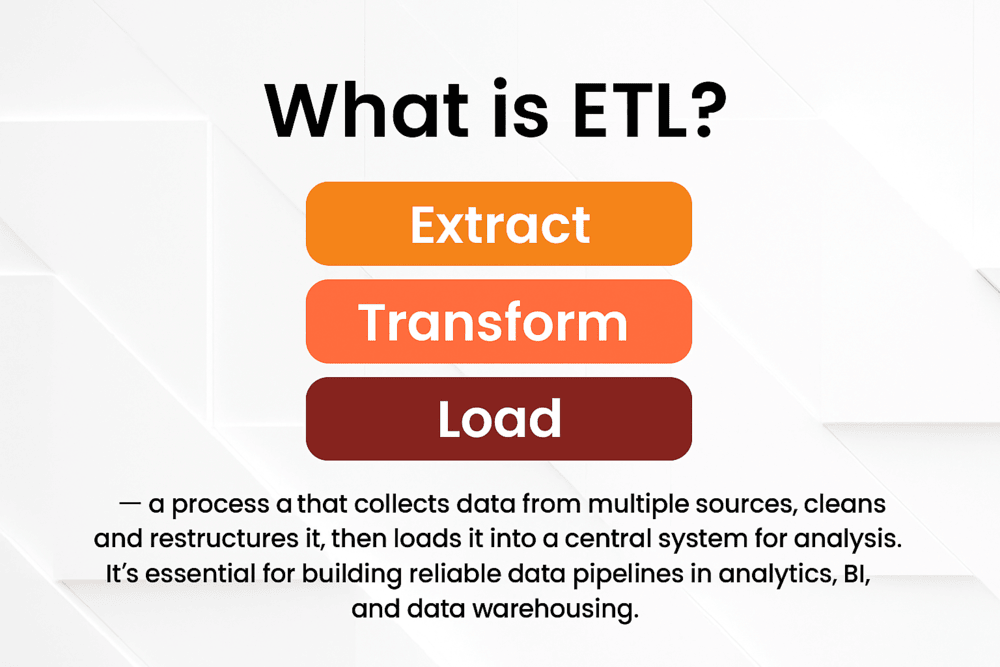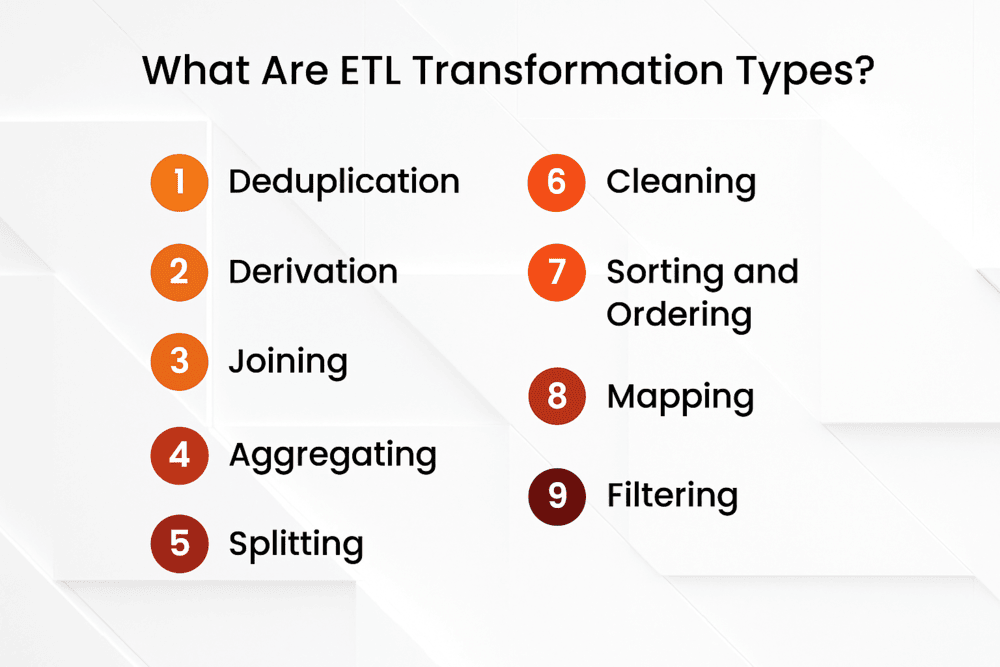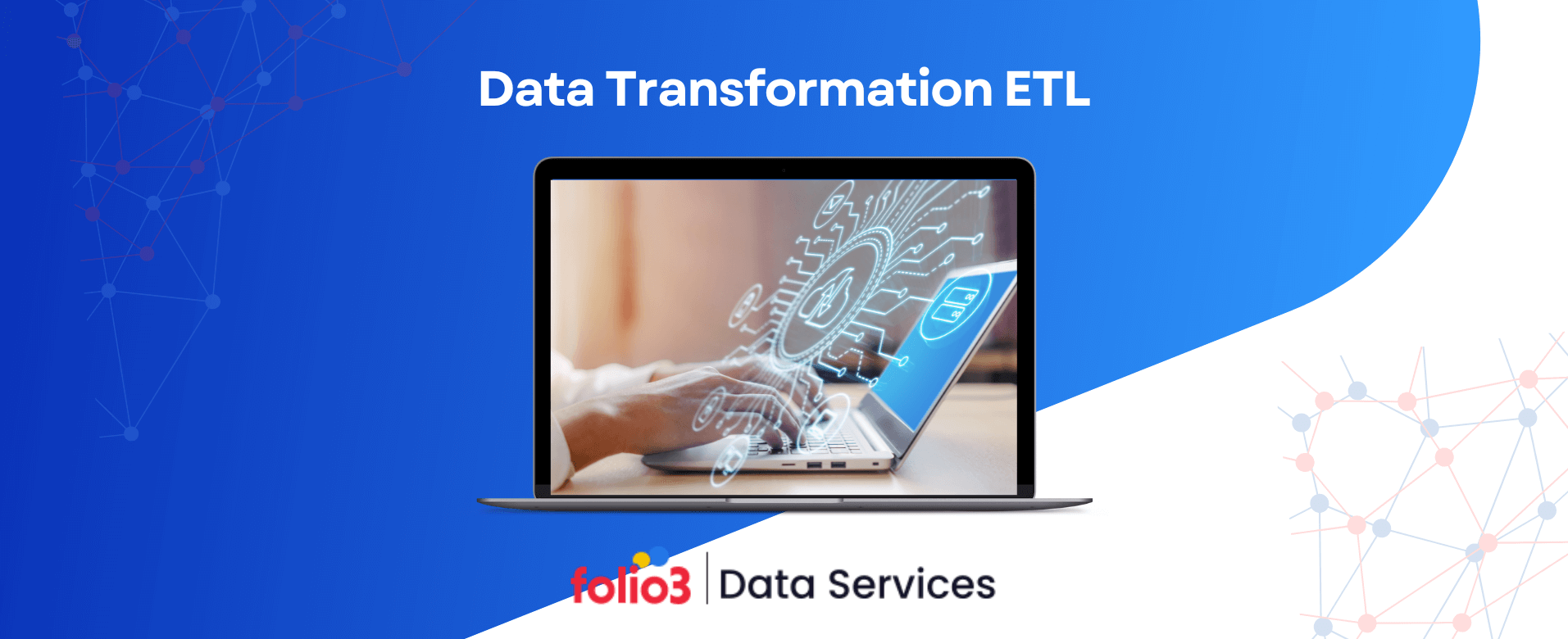Organizations rely on seamless data management processes to derive actionable insights and maintain a competitive edge. At the heart of these processes lies the ETL (Extract, Transform, Load) framework, a systematic method of collecting data from multiple sources, modifying it to fit analytical or operational needs, and loading it into a centralized repository.
Data transformation is pivotal among the three phases of ETL It involves converting raw, inconsistent datasets into a structured, usable format, ensuring data accuracy and relevance. This transformation is crucial for harmonizing disparate data sources and enabling businesses to make well-informed decisions.
ETL data transformation is a cornerstone of efficient data handling, from merging customer data across platforms to standardizing financial reports. Moreover, the ETL data processing stage highlights how data transformation enables businesses to uncover trends, predict future outcomes, and adapt strategies for success.
ETL transformation examples include removing duplicates, formatting dates, and enriching datasets to create a unified, actionable information view. Whether through ETL data conversion or complex analytics preparation, the transformation phase underpins the entire process, ensuring that raw data evolves into meaningful insights.
In this blog, we will explain all you need to know about data transformation in ETL.
What is ETL?
ETL, short for Extract, Transform, Load, is a structured data integration process that enables organizations to gather, clean, and store data from various sources into a unified system for analysis and decision-making. It is widely used in data warehousing, business intelligence, and analytics to ensure data consistency and accessibility. Let’s break down the three core stages:

1. Extract
The extraction phase involves collecting raw data from different sources such as databases, spreadsheets, APIs, or cloud storage systems. These sources can be structured (e.g., SQL databases), semi-structured (e.g., JSON files), or unstructured (e.g., text documents). This stage aims to gather data without disrupting the source systems.
2. Transform
Transformation converts the extracted raw data into a structured, consistent, and usable format. This is where the magic happens. Using transformation in ETL, data undergoes operations such as:
- Data cleansing: Fixing errors, removing duplicates, and filling missing values.
- Data standardization: Converting data to a standard format (e.g., standardizing date formats).
- Data mapping and enrichment: Aligning data fields and adding additional contextual information.
This phase ensures data is accurate, relevant, and ready for analysis.
3. Load
The load phase involves moving the transformed data into a target system, such as a data warehouse, data lake, or business intelligence platform. Depending on the use case, the loading can occur in batches or real-time. This stage makes data available for analytics, reporting, and visualization, supporting solutions like cloud data lakes consulting services to optimize data management and utilization.
What Are ETL Transformation Types?
ETL transformation involves numerous operations to prepare raw data for meaningful analysis. These operations ensure data integrity, consistency, and relevance, critical for informed decision-making. Each ETL transformation type plays a vital role in converting raw, disparate datasets into structured, actionable insights, forming a cornerstone of effective data engineering services.
Whether removing duplicates, aggregating metrics, or cleaning data for accuracy, these transformations ensure that businesses derive maximum value from their data. By employing advanced techniques and tools for ETL data conversion and transformation, organizations can streamline their ETL data processing workflows and unlock the full potential of their data assets. Understanding the different types of data transformation in ETL is essential to applying the right methods for specific business needs.
Here’s a detailed look at the primary ETL transformation types:

1. Deduplication
Deduplication is a key ETL transformation process where redundant or duplicate records are removed. This ensures that datasets remain clean, consistent, and free of repetitive entries. For instance, in ETL data transformation for customer management systems, duplicate customer profiles are merged or eliminated to avoid redundancy and errors. This is one of the most widely used data transformation techniques to improve data quality.
2. Derivation
Derivation refers to creating new data fields by transforming existing ones. This can involve calculations or applying predefined rules. A practical example of this transformation in ETL is deriving a customer’s age from their date of birth or calculating profit margins from revenue and costs. Among common ETL data transformation examples, derivation simplifies downstream analysis by providing ready-to-use metrics.
3. Joining
Joining combines data from multiple sources or tables into a unified dataset. ETL data processing is beneficial for businesses consolidating information from various departments. For example, ETL transformation examples include merging sales data with customer demographics to generate more insightful reports.
4. Aggregating
Aggregation involves summarizing detailed data for higher-level insights. Standard aggregation techniques include computing averages, sums, or counts. For instance, ETL data transformation can aggregate monthly sales figures to analyze quarterly or annual performance trends, providing a big-picture view for strategic decisions.
5. Splitting
Splitting is dividing a single column or dataset into multiple parts. This is often necessary when dealing with complex or concatenated data. For example, an address field containing street, city, and zip code can be split into separate fields for more straightforward analysis and ETL data conversion tasks.
6. Cleaning
Data cleaning is fundamental to ensuring input data is free from errors, inconsistencies, or irrelevant information. Cleaning might involve correcting typos, filling missing values, or standardizing formats. For instance, in ETL data processing, dates formatted differently across datasets can be standardized to a single format, such as YYYY-MM-DD.
7. Sorting and Ordering
Sorting and ordering organize data in a specific sequence, such as ascending or descending order based on a key column. This transformation ensures data is prepared for further processing or reporting. For example, sorting sales data by transaction value allows businesses to identify their highest or lowest-performing products quickly.
8. Mapping
Mapping involves aligning data from various sources to a standardized schema or structure. It is essential for harmonizing datasets, especially in ETL data transformation projects with multiple data sources. A real-world example is mapping product categories from different sales platforms to a unified taxonomy for consistent reporting.
9. Filtering
Filtering eliminates unnecessary or irrelevant data based on predefined criteria. This ensures that only the most pertinent data is processed and stored. For instance, ETL transformations types with examples include filtering transactions to include only those above a certain value or excluding incomplete customer records. This helps maintain data quality and relevance for analysis.
Organizations leveraging Snowflake consulting often apply these filtering techniques within cloud data platforms to ensure scalable, high-performance analytics environments.
Applications of Data Transformation in ETL
ETL transformation is essential for converting raw data into actionable insights that drive business success. It enables organizations to process, clean, and refine their data, making it more accessible and valuable across various applications. These capabilities are foundational to data analytics and digital transformation, empowering businesses to become more agile, data-driven, and innovation-ready.
Whether it’s preparing data for a warehouse, supporting real-time analytics, or merging datasets for unified insights, ETL data transformation ensures that businesses can harness the full potential of their data. With robust ETL data processing techniques, organizations can drive smarter decisions, improve operational efficiency, and stay ahead in a competitive landscape.
Below, we delve into the key areas where ETL data transformation plays a transformative role.
1. Data Warehousing and Business Intelligence
Data transformation is fundamental in preparing data for storage in data warehouses, where it can be efficiently accessed for business intelligence purposes.
- Through ETL and ELT data conversion, disparate data from various systems is standardized and formatted to align with the warehouse schema.
- ETL transformation examples include consolidating sales, marketing, and operations data into a unified warehouse to create comprehensive dashboards.
- Once processed, this data can generate reports, uncover trends, and support strategic decision-making.
For instance, an e-commerce company might transform sales and customer data into actionable insights about purchasing behaviors and seasonal trends, enabling targeted marketing campaigns.
2. Real-Time Analytics and Reporting
Real-time insights are critical for staying competitive in today’s fast-paced business environment. Data transformation enables the seamless integration and analysis of live data streams.
- Using ETL data processing, raw data from IoT devices, transaction systems, or social media platforms is cleaned and enriched in near real-time.
- Transformed data is loaded into real-time data warehousing systems to support live dashboards and instant alerts.
For example, logistics companies can use real-time analytics to track fleet performance, optimize routes, and improve delivery times. Robustbust transformation in the ETL process makes this agility possible.
3. Machine Learning Model Preparation
High-quality, well-structured data is crucial for machine learning (ML) models to function effectively. ETL data transformation helps prepare datasets for training and testing models.
- Transformation techniques like deduplication, cleaning, and splitting ensure that data is consistent and free of noise.
- ETL transformation examples in ML include feature engineering deriving new variables or metrics from raw data to enhance model accuracy.
For instance, a financial institution may transform customer transaction data to develop fraud detection models, extracting key features such as transaction frequency and location patterns.
4. Merging Data from Multiple Systems for Unified Insights
Organizations often operate across diverse platforms, creating silos of data. Data transformation is vital for integrating and unifying these disparate sources, a process often streamlined with the help of data integration consultancy services.
- By mapping fields and reconciling discrepancies, ETL data processing ensures a seamless data merger from multiple systems.
- ETL data conversion processes may also involve standardizing formats to enable cross-platform compatibility.
For example, a global retailer might merge data from regional inventory systems to provide centralized visibility into stock levels, enabling better supply chain management.
The Role of Data Transformation in ETL
Data transformation is the pivotal phase within the ETL (Extract, Transform, Load) process. It converts raw, unstructured, or inconsistent data into a clean, structured, and usable format. This phase bridges the gap between disparate data sources and actionable insights, ensuring organizations can trust their data for analytics, reporting, and decision-making. Efficient transformation is also a key component of building robust data pipelines, which automate and streamline data flow across systems.
Here’s how data transformation plays a critical role in ETL:
- Standardizing Diverse Data Sources: Businesses often gather data from multiple sources with unique formats and structures. Data transformation ensures consistency by aligning this data to a standard schema, enabling seamless integration and comparison.
- Improving Data Quality: Data transformation eliminates errors, inaccuracies, and redundancies through processes like deduplication, cleansing, and validation, ensuring the reliability of the information used for analysis.
- Enhancing Data Usability: Transformation processes like aggregation, derivation, and enrichment turn raw data into meaningful insights. For instance, transforming transactional data into customer behavior patterns helps businesses make informed decisions.
- Enabling Advanced Analytics: High-quality, well-structured data is essential for real-time analytics, machine learning, and predictive modeling. Data transformation ensures that datasets are prepared to meet the technical requirements of these advanced applications.
- Supporting Scalability and Automation: Automation tools and frameworks allow transformed data to be processed at scale, meeting the growing demands of big data and enterprise analytics.
ETL Transformation Summary
ETL transformation is the critical phase in the Extract, Transform, Load (ETL) process that converts raw, inconsistent data into structured, actionable insights. This blog explains key transformation types—deduplication, aggregation, derivation, cleaning, mapping, and more—along with their real-world applications in data warehousing, business intelligence, machine learning, and real-time analytics. Efficient ETL transformation ensures data accuracy, usability, and scalability, enabling organizations to make informed decisions and drive business value.
FAQs
What is ETL and why is it important?
ETL (Extract, Transform, Load) is a process that collects data from multiple sources, transforms it into a consistent format, and loads it into a target system such as a data warehouse. It ensures data accuracy, usability, and accessibility, supporting analytics, reporting, and informed business decisions.
What are the main types of ETL data transformations?
Key ETL transformation types include deduplication, derivation, joining, aggregation, splitting, cleaning, sorting, mapping, and filtering. Each type ensures data is accurate, consistent, and structured for analysis or machine learning.
How does data transformation improve data quality in ETL?
Data transformation cleans, standardizes, and validates raw data, removing duplicates and inconsistencies. This improves reliability and usability, ensuring businesses have trustworthy datasets for analytics, reporting, and AI applications.
What are common use cases of ETL data transformation?
ETL data transformation is used in data warehousing, business intelligence, real-time analytics, machine learning model preparation, and merging data from multiple systems for unified insights. It enables actionable reporting and smarter decision-making.
Why is transformation the most critical phase in ETL?
Transformation converts raw, unstructured, or inconsistent data into clean, structured, and usable formats. It standardizes diverse sources, enhances data usability, improves quality, and prepares data for advanced analytics and scalable pipelines.
How does ETL transformation support real-time analytics?
By cleaning, enriching, and structuring live data streams from IoT devices, transaction systems, or social media, ETL transformation enables near real-time dashboards and alerts, helping organizations respond quickly to operational and market changes.
What role does ETL play in machine learning preparation?
ETL transformation prepares high-quality datasets for training and testing ML models. It includes deduplication, cleaning, splitting, and feature engineering to ensure consistency, accuracy, and model-ready data for predictive analytics.
How does ETL help merge data from multiple systems?
ETL transformation maps, standardizes, and reconciles datasets from different sources, creating unified insights. This reduces silos, improves reporting, and enables centralized data for analytics or business intelligence platforms.
What are some examples of ETL transformation in action?
Examples include removing duplicate customer records, standardizing date formats, aggregating sales metrics, deriving new variables, and filtering irrelevant transactions. These transformations turn raw data into actionable insights.
How can businesses optimize their ETL processes?
Businesses can optimize ETL by automating workflows, using advanced ETL tools, and partnering with data integration or cloud data consultancy services. This streamlines data pipelines, ensures scalability, and maximizes the value of analytics and AI initiatives.
Conclusion
ETL data transformation is essential for turning raw datasets into actionable insights, enabling businesses to make smarter decisions and stay competitive. This process ensures data accuracy, standardization, and readiness for analytics, driving innovation across industries like data warehousing, real-time analytics, and machine learning.
For organizations looking to optimize their ETL processes, Folio3 Data Services offer tailored solutions to streamline workflows, integrate disparate data systems, and unlock the full potential of your data. Partner with Folio3 to transform your data into a strategic asset and achieve measurable business success.



